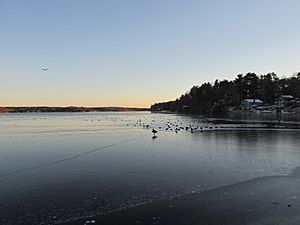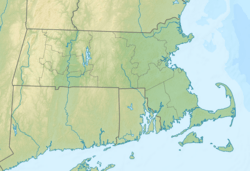Great Herring Pond facts for kids
Quick facts for kids Great Herring Pond |
|
|---|---|

Great Herring Pond
|
|
| Location | Plymouth and Bourne, Massachusetts |
| Coordinates | 41°48′27″N 70°33′53″W / 41.80750°N 70.56472°W |
| Primary inflows | Little Herring Pond |
| Primary outflows | Herring River |
| Basin countries | United States |
| Surface area | 376 acres (1.5 km2) |
| Average depth | 20 ft (6.1 m) |
| Max. depth | 42 ft (13 m) |
| Surface elevation | 33 ft (10 m) |
| Settlements | Pondville (Cedarville section of Plymouth) |
Great Herring Pond is a large, warm water pond located mostly in Plymouth, Massachusetts. A small part of the pond also reaches into Bourne. It covers about 376-acre (1.5 km2), which is like 285 football fields! The village of Pondville, part of Cedarville, sits right on the eastern side of the pond.
This pond is about 20 ft (6.1 m) deep on average, but in some spots, it can go down to 42 ft (13 m). The bottom of the pond is made of sand, rocks, and soft mud. To help fish find places to hide, a special "tire reef" was put in the pond in 1979. Water flows into Great Herring Pond from Little Herring Pond, and then it flows out into the Herring River in Bourne.
If you want to visit, there's a public boat ramp in Bourne. It's a gravel ramp that goes into shallow water, so it's best for small boats like canoes or inflatable rafts that you can carry easily.
Contents
Discovering Great Herring Pond's Wildlife
Great Herring Pond is home to many interesting creatures. Sometimes, people have reported seeing very large turtles in the pond.
Giant Turtles of the Pond
Imagine seeing a turtle that's 4 to 5 feet long! That's how big some of the turtles seen in Great Herring Pond are. Their heads are as big as footballs! These huge turtles have been spotted floating downstream from Little Herring Pond, especially near Carters Bridge. It's quite a sight to see such massive reptiles in the water.
A Glimpse into History
Great Herring Pond has a rich history, especially from the time when early European settlers arrived.
Native American Village Life
Long ago, in colonial times, a large village of Native Americans lived near the pond. They were Christian Indians and their village was called Comassekumkanet. In their language, Algonquin, this name means "on the other side of the prince's house." It tells us a bit about how they saw their home.
Early Settlers and Community
An early settler named Thomas Tupper often preached to the Native American community. Even though he wasn't officially a minister, he shared his beliefs with them. This shows how different communities interacted and lived alongside each other in those early days.



